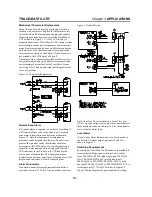
TRACE
MATE II-CTR
Chapter 4 Operation
4.2
High Temperature Alarm Setpoint: If the jumper is at HT
position, the Setpoint Number is interpreted as the high
temperature alarm setpoint in °C or °F for the selected
heater. The factory default value is 100°C.
Ground Fault Trip Alarm Setpoint: If the jumper at GF
position, the Setpoint Number is interpreted as the ground
fault trip alarm setpoint in mA for the selected heater. The
factory default value is 30 mA.
Current Fail Alarm Setpoint: If the jumper is at AMP
position, the Setpoint Number divided by 10 is inter-
preted as the current fail alarm setpoint in A for the
selected heater. The factory default value is 0.3 A.
NONE: If the jumper is at NONE position, the Setpoint
Number has no meaning to any heater.
Once the jumper is at NONE position, all the adjusted
setpoints will be saved in EEPROM which means that
their values will not be changed even after power off.
It would be very helpful to use the setpoint messages on
the LCD display to verify if the desired setpoint has been
properly set or not.
1. For heater x’s setpoint, the message is “SPx = ---°C”,
or “SPx = ---°F”. Where, x refers to the heater number. It
could be either 1 or 2. This message would be the sole
message on the display if JP1 is at SP position.
2. For heater x’s low temperature alarm setpoint, the
message is “LT SPx = ---°C”, or “LT SPx = ---°F”. This
message would be the sole message on the display if JP1
is at LT position.
3. For heater x’s high temperature alarm setpoint, the
message is “HT SPx = ---°C”, or “HT SPx = ---°F”. This
message would be the sole message on the display if JP1
is at HT position.
4. For heater x’s current fail alarm setpoint, the message
is “AMP SPx = --- A”. This message would be the sole
message on the display if JP1 is at AMP position.
5. For heater x’s ground fault trip alarm setpoint, the
message is “GF SPx = --- mA”. This message would be
the sole message on the display if JP1 is at GF position.
6. If JP1 is at NONE position, the messages such as
system measurements, setpoint values, heater on/off and
alarm status will be continously cycled through on the
LCD display.
to the factory for service.
Heater On Indicator: Whenever a heater is on, the green
HTR ON indicator LED will be on if the heater is
selected by S12, refer to Figure 2.1. This is useful for
checking correct operation of the control. If the ground
fault alarm light or RTD fail alarm light is on, the heater
will not switch on even if the actual temperature is below
the setpoint.
Alarm Reset
The low/high temperature and RTD fail alarms reset as
soon as the condition disappears. The ground fault trip
and current fail alarm are latched alarms. A latched alarm
will remain even if the alarm condition disappears. To
reset the latched alarms, remove heater 1’s incoming
power for a few seconds by opening and reclosing the
circuit breaker. Provided the alarm conditions are no
longer present, the alarms should all be reset when power
is re-applied. It is also possible to use S11 to reset the
latched alarms on the selected heater. To do that, first use
S12 to select the heater, and then momentarily switch S11
towards its ON position ( refer to Figure 2.1 ).
Heater Setpoint and Alarm Setpoints
As stated in chapter 2, five setpoints can be adjusted by
properly setting up S1-9, S10, S12 and JP1 ( refer to
Figure 2.1 ). S1-9 consisits of 9 switches. They are S1,
S2, S3, S4, S5, S6, S7, S8 and S9. These 9 switches
generate a Setpoint Number in a range of 0-511. The
exact value of this Setpoint Number equals the sum of the
contributions from each switch. If a switch is in ON
position, its contribution to the Setpoint Number equals
its labelled value on the board. Otherwise, its contribution
is zero. For example, if all 9 switches are all in ON
position, Setpoint Number = 1 + 2 + 4 + 8 + 16 + 32 + 64
+ 128 + 256 = 511. If only switches S3 and S5 are in ON
position, Setpoint Number = 0 + 0 + 4 + 0 + 16 + 0 + 0 +
0 + 0 = 20.
Whether the Setpoint Number is for heater 1 or heater 2
depends on the position of switch S12.
Depending on the jumper position of JP1, the Setpoint
Number generated by S1-9 can be interpreted as either
heater setpoint, or low temperature alarm setpoint, or high
temperature alarm setpoint, or ground fault trip alarm
setpoint, or current fail alarm setpoint.
Heater Setpoint: If the jumper is at SP position, the
Setpoint Number is interpreted as the heater setpoint for
the selected heater. Whether the setpoint is in °C or °F
depends on the position of S10 ( refer to Figure 2.1 ). The
factory default value is 20°C.
Low Temperature Alarm Setpoint: If the jumper is at LT
position, the Setpoint Number is interpreted as the low
temperature alarm setpoint in °C or °F for the selected
heater. The factory default value is 5°C.















